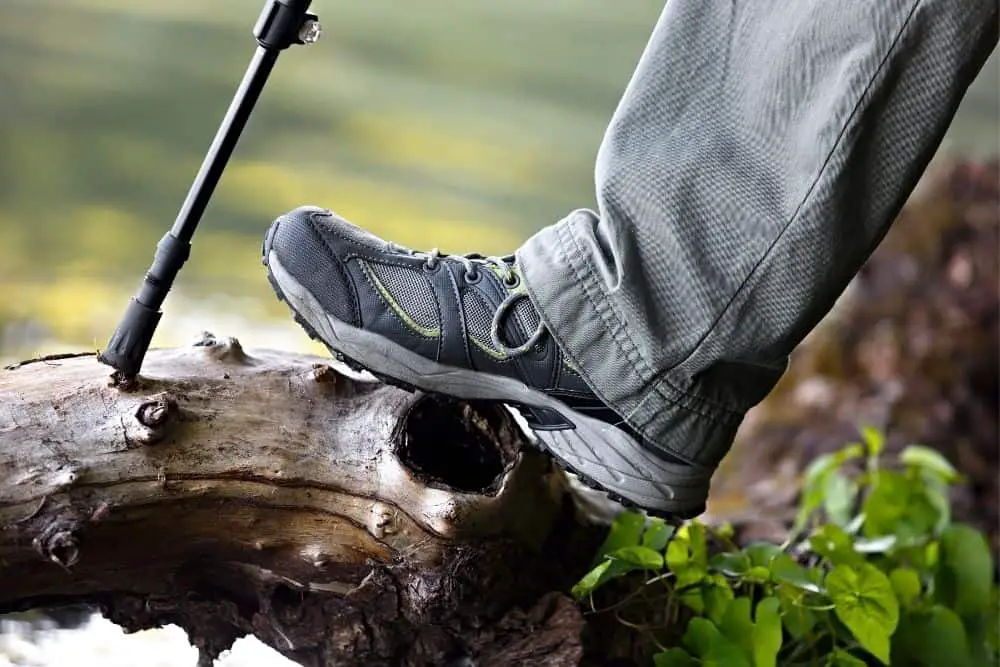Whether you are a hiker or not, as long as you wear hiking boots, you have at one point felt the heat in your footwear. In cold or freezing weather conditions, this can be an advantage. However, it could be the cause of sweaty feet, during hot weather conditions.
Many people who have suffered sweaty feet wearing this footwear have asked, “how to keep feet cool in hiking boots”. And like you, these people stumbled upon this article and got the desired guide they needed.
As we go on with this article, you will discover the numerous ways you can combat the heat in the interior of hiking boots. But, first, we would explain the methods to keep your feet cool alongside their pros and cons.
However, before proceeding, we would like to highlight some significant reasons why your feet might feel hot in hiking boots. In other words, let’s see the causes of heat on the inside of hiking boots. Let’s get started!
Contents
Why Hiking Boots Make Your Feet Hot?
If you have ever tried on different types and brands of hiking boots, you will discover that they mostly share one unique description, “hot (or warm interior). Although some hiking boots have warmer interiors than others, they utterly share similar consequences if left unchecked.
During our first adventure with hiking boots, the warmness we felt on our feet made us curious. And over the years, consistently trying out different brands and types of hiking boots, it increased our curiosity about why they feel hot inside.
Like you, we asked these questions and did extensive research on the construction and design of hiking boots. And from these researches, we discovered several leading and minor factors that contribute to the interior warmth of hiking boots.
Moreover, know that the warmth in hiking boots might be advantageous during lower temperatures or in the winter. However, several consequences tend to follow when you begin to feel the “hotness” of hiking boots interior during higher temperatures like summer.
1. Insulation

Although not many hiking boots come with insulation membranes or properties, they are significant heat promoters in hiking boots. Generally, insulated hiking boots’ manufacturers make this footwear for cold (or freezing) weather conditions like the winter.
When it is winter, the cold atmosphere will trigger your human body to desire heat, hence increasing the warmth in your hiking boots. But, during a season like summer, the atmospheric temperature is high, so adding insulated hiking boots would become excessive.
Now, when hikers, Special Forces, mountaineers, or anyone else wears insulated hiking boots during other seasons, except winter, it could feel pretty hot inside. Why? The design of insulated hiking boots prevents the flow of air into them, which ultimately results in heat.
The membrane for insulating hiking boots covers all vents and holes that usually allow proper airflow around the footwear—generating heat on your feet while wearing them.
2. Thick Socks
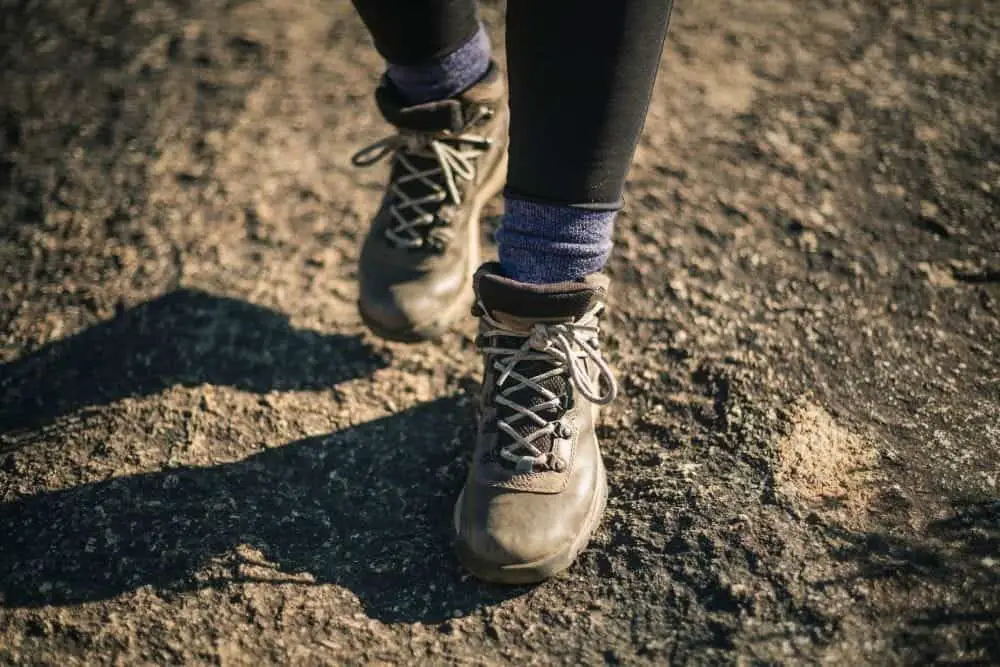
You might doubt this, but it’s the truth, the thickness of your socks can generate interior hiking boot heat. We understand that hiking socks usually have breathability, which supposedly prevents sweaty feet from heat build-up, but it can sometimes fail.
Generally, the breathability and allowance of airflow in hiking socks depend on two significant factors; thickness and material. Wearing thick socks will cause more heat to build up in your hiking boot, leading to hot feet.
Moreover, the choice of material during production determines the moisture-wicking capability and breathability. For instance, cotton is lighter and more breathable for hot weather conditions. Whereas wearing wool socks would cause more generated heat on your feet.
3. Wrong-Sized Hiking Boots
We always recommend to hikers that their hiking boots must fit snugly, and these are global recommendations. However, it can become a problem when they feel extremely tight on their feet, especially with no space for toe wiggling.
Generally, when footwear fits extremely tight, it prevents the flow of air from cooling the feet. And this is a likely case with highly tight hiking boots. As a result, the expected room space for proper airflow around the feet is absent, generating heat with the hiking boot.
Also, the extreme snug fit prevents the moisture-wicking properties of hiking boots from cooling the feet. The vented holes and eyelets become incapable of allowing air to sneak into the hiking boots.
4. Material Choice
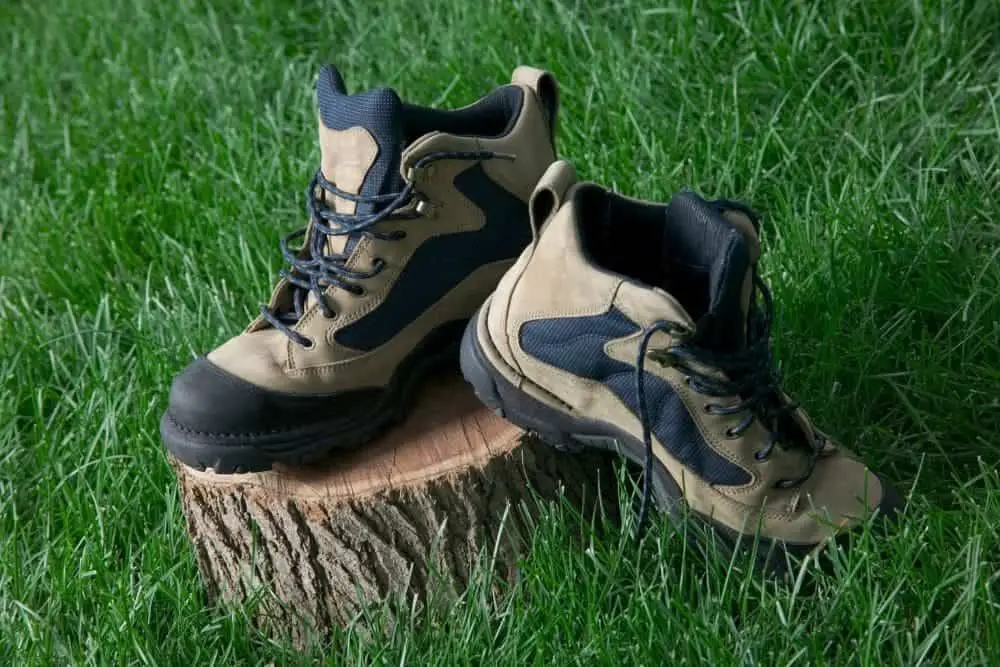
Aside from the breathable membrane that usually lines the upper part of hiking boots, the material overlying this membrane also plays a role. When the material choice isn’t the best, the hiking boot tends to feel pretty hot and uncomfortable for wearers.
For instance, hiking boots coming with leather are already famous for being poor breathable materials, especially the full-grain and split-grain types. So having a hiking boot with these leathers in the upper part translates to one with hot interiors.
Furthermore, some synthetic fabric choices have also proven to produce heat, although they are often as breathable as mesh designs. With that stated, hiking boots with full-grain and split-grain leather will make your feet feel hot, especially during hot weather conditions.
5. Waterproof Membrane
This would probably be one of the most disputed truths by many hiking boots lovers, but it’s the truth. We understand that some untrustful waterproof membrane for hiking boots, usually has moderate breathable capabilities, so it can still increase the overall heat quite a lot.
Personally, the waterproof membrane is among the “minor” factors causing hiking boots to have a hot interior. Why? The idea of the lining (or membrane) is to prevent even the tiniest drop of fluid from slipping into the hiking boot, which can at the same time prevent proper airflow.
Usually, the waterproof membrane is put under all over the upper of hiking boots, and when proper airflow becomes disturbed, the moisture-wicking properties aren’t enough to prevent the heat. And this leads to hot hiking boots interior and sweaty feet.
6. Water-resistant/water-repellent coating
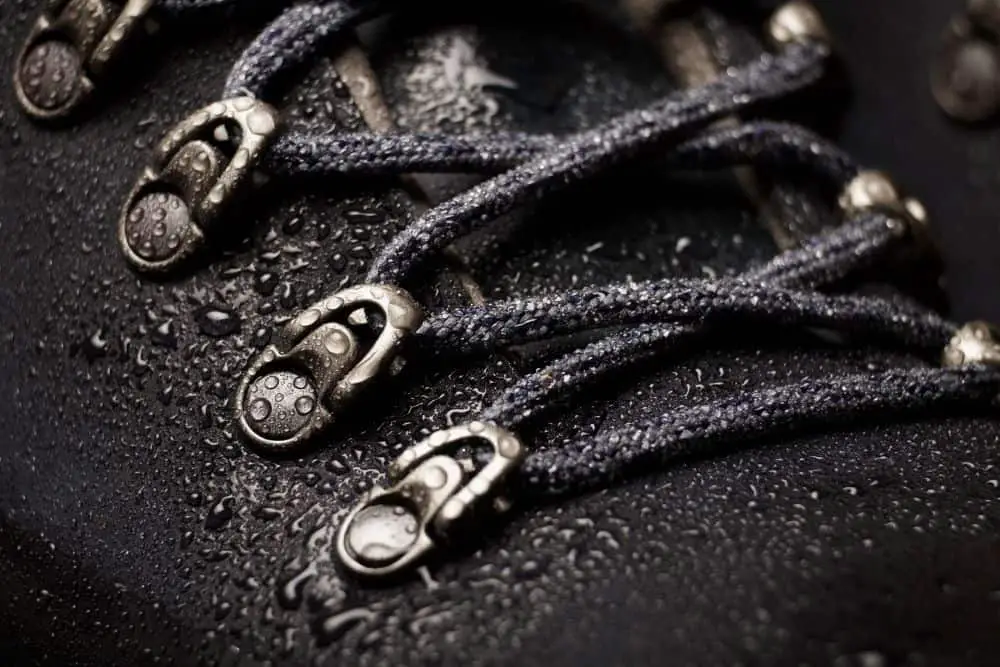
Waterproofness is often a vital feature of hiking boots regardless of whether the wearer is planning to get on the trip in the mountains, forests or burning sandy areas like the desert.
But since streams, rivers or large puddles are present everywhere in your journey, I bet you won’t love the feeling of accompanying wet feet all over places.
However, let’s face it, many people really feel awkward when choosing a pair of hiking boots that are coated with a water-resistant layer on the entire outer surface.
For sure, this waterproof coating will prevent the breathing of leather or fabrics as well as reduce air circulation in and out of the boots, causing hot feet inside. This is even worse if you wear a pair of high-collar hiking boots.
The best way to get rid of this heat is to find and wear low-cut/mid-cut boots that have obvious vented holes or massive petite holes along the sides of the footwear.
Thanks to that, even when a waterproof coating is applied to the entire boot, these holes are getting filled or blocked easily. This reduces the chance of feet sweating all the way due to excessive heat.
As a result, your feet are being cooled down without sacrificing water resistance.
Consequences of hot feet in hiking boots
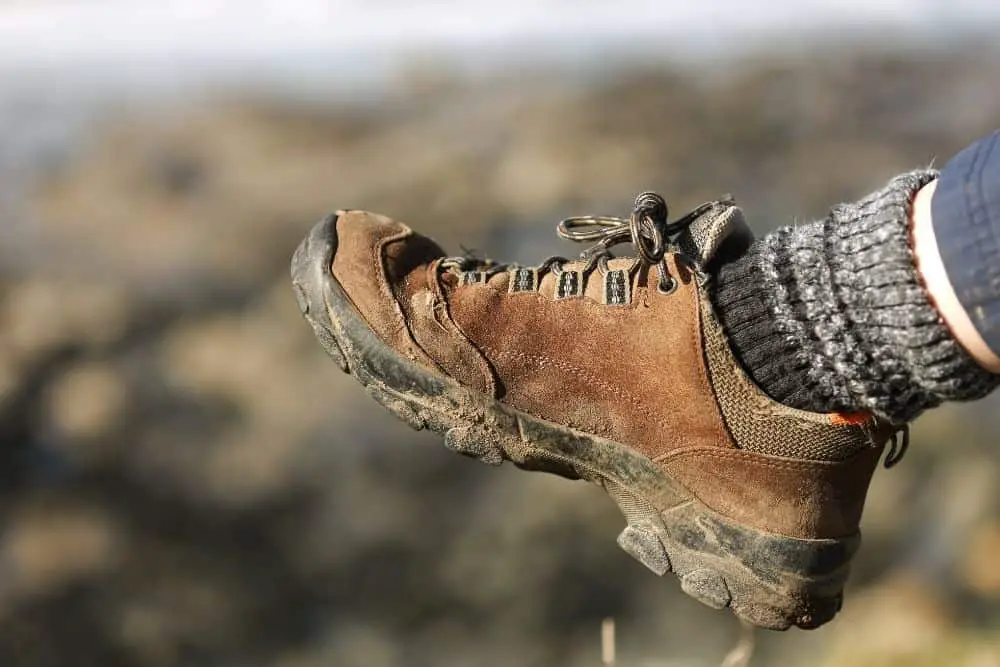
Although the aim of wearing hiking boots is to protect your feet, the footwear can become a danger if left unchecked. So first off, you need to know all about hiking boots and how to handle them before wearing them.
Should you ignore any of the above-listed causes of the hot interior in hiking boots, you subject your feet to several consequences. So, what are the consequences you face from having hot feet in hiking boots?
- Sweaty feet – your feet will sweat more.
- Blisters.
- Stinky hiking boots and feet.
- Diminishes the hiking boot’s quality.
- Foot pains/sores.
- Foot-related medical conditions like Grierson-Gopaian syndrome.
How To Keep Feet Cool In Hiking Boots?
Let’s be honest with you; you can never totally avoid sweaty feet while wearing hiking boots, especially in hot weather conditions.
However, there are ways to manage and even overcome the situation before it escalates into further consequences.
Generally, hiking boots’ manufacturers install specific designs or features that combat sweaty feet and keep them cool. These designs help to keep your feet dry and cool, even in the hottest of conditions.
Regardless, how to keep your feet cool in hiking boots doesn’t only have to do with the footwear, but the foot as well. So let’s see some ways for you to keep (or maintain) a cool temperature in your hiking boot.
1. Eyelets and Vented Holes
These features are common to combat, tactical, work, and hiking boots. For hiking boots, they tend to act like small pockets of windows for air into the hiking boots.
Manufacturers understand that hiking boots can become hot, even without the atmospheric temperature being high. For that reason, they installed eyelets in the upper and several vented holes around the hiking boots.
These features allow proper airflow inside the hiking boot, thereby exchanging the hot air in the footwear with cool ones from the outside. This continuous process ensures stable and cool-temperature feet inside the hiking boot.
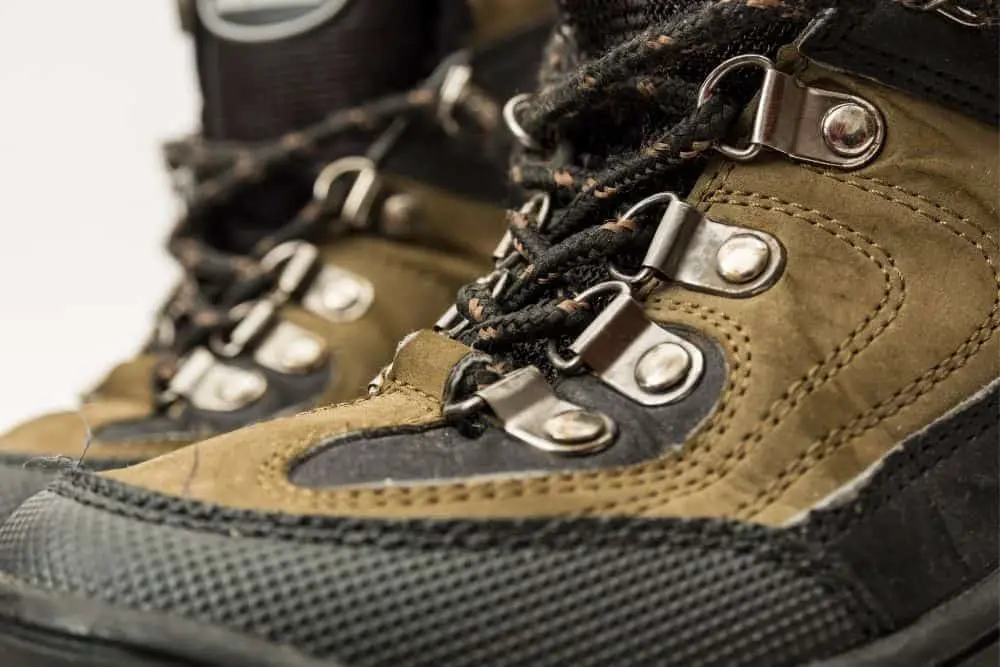
Pros
- Promote appropriate airflow within the hiking boot.
- Keep your feet dry.
Con
- Allow water or fluid to get into the hiking boots.
2. Breathable Lining
Next to the presence of eyelets and vented holes in keeping your feet cool in hiking boots would be breathable membranes and linings. These features serve one primary purpose, which is to wick moisture or remove sweat from feet.
Generally, different manufacturers create breathable linings. The GORE-Tex, eVent breathable linings ensure that your foot moisture or sweat wick properly.
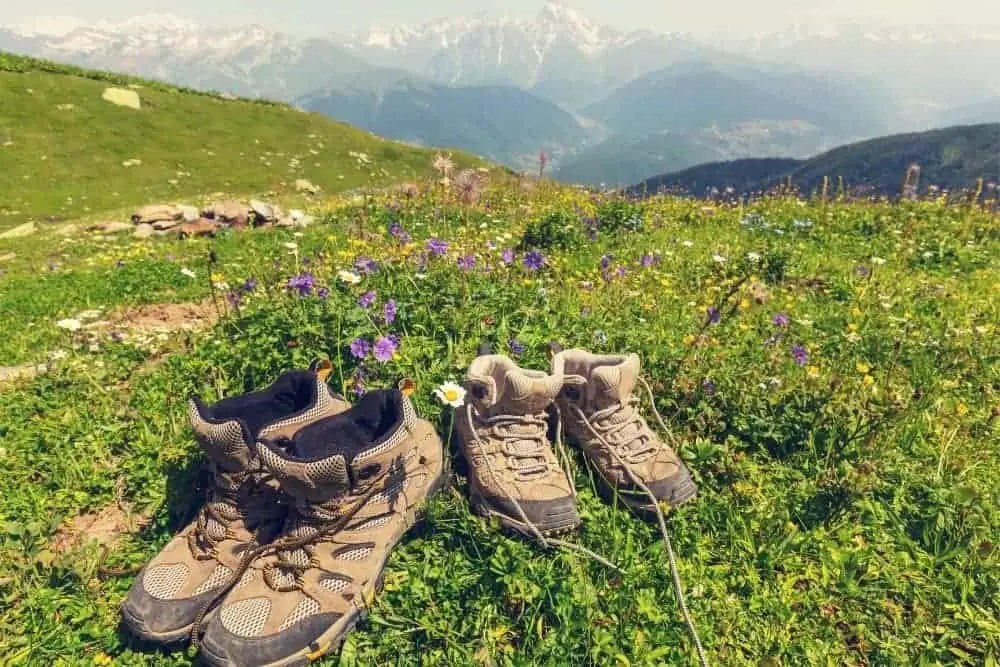
Pros
- Wick foot moisture.
- Keep Feet dry.
Con
- Usually come at a high price.
3. Breathable Materials
Here’s the truth; the breathable lining surrounding your hiking boot isn’t the only design meant to keep your feet cool. You got that right! The right choice of material also plays a significant role in determining the temperature and moisture-wicking capabilities.
As earlier stated, leather isn’t the most advisable material to choose for your hiking boot upper if you want to prevent heat build-up within the footwear. However, nubuck leather is a more advisable option if you must pick leather for the upper.
Nevertheless, how to keep your feet cool in hiking boots using material would be with mesh or Denier Nylon fabric designs. Both of these materials wick moisture from the interior to the boot’s exterior, plus they allow proper airflow inside the footwear.

Pros
- Aid moisture-wicking properties of the breathable linings.
- Allow for slight airflow around the footwear.
Cons
- Increase the overall weight of the hiking boot.
- Mesh and Denier Nylon might be moderately durable.
4. Go For Moisture-wicking Insoles
If you didn’t know, the insole part of your hiking boot comes in direct contact with your feet, precisely the bottom. And insoles primarily come in different shapes and types. For instance, there are moisture-wicking ones and gel versions.
If you sweat severely, you might want to consider the moisture-wicking version of insoles to keep your feet cool and dry. How?
These moisture-wicking insoles made from hard-wearing natural cotton absorb all the sweat from your feet and between your toes to keep it dry. Furthermore, the lower part of the insole has perforated and grooved antibacterial skin that helps to keep the odor at bay.
Then, you will even get additional foot support and added comfortability with moisture-wicking insoles than any other. For instance, the gel versions of insoles mainly create heat and are perfect for colder conditions.

Pros
- Support feet.
- Wick moisture.
- Improve foot comfortability.
Con
- The gel insoles cause heat in hot conditions.
5. Find The Right Fitting
Generally, the fitting of hiking boots for your feet should be snug but have enough space for your toes to wiggle and air to flow. If your feet feel extremely tight in hiking boots, it will reduce the chances of proper airflow in and around the footwear
We advise that the best way to keep your feet cool through appropriate sizing would be by picking the right fitting hiking boot. This way, the material will wick moisture excellently, and the vented holes will allow air to dry the feet better.
However, if you already have an overly tight hiking boot, there is a way to try relieving the heat it builds up. For instance, you might want to loosen up the laces of your hiking boot to allow more air into the footwear to cool your feet.
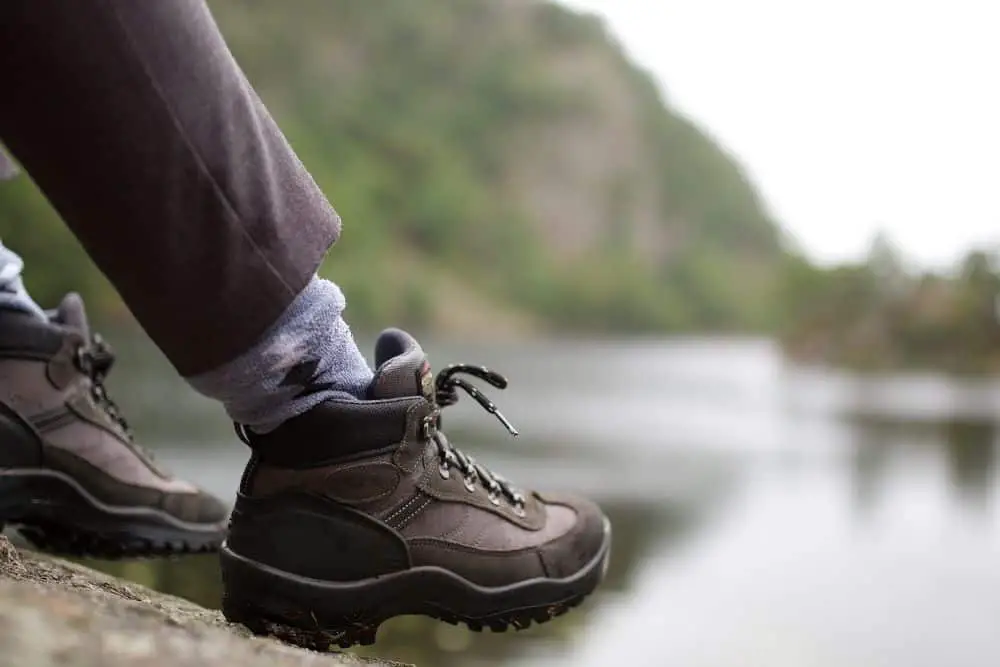
Pros
- It makes your feet feel comfortable.
- Prevent blisters.
- Allow air to flow around the foot.
Con
- It might be pretty difficult to spot the “right fitting” hiking boot as some tend to run narrow or wide.
6. Pick Lightweight Hiking Boots
Although hiking boots are typically more lightweight than many other heavy-duty footwear, it’s still best to pick the light ones amongst them. Why? Wearing heavy hiking boots will cause strain, requiring you to exert more strength to move with the footwear.
Once this begins to happen, your feet will sweat faster, even on a day with cool weather conditions. Unlike the lightweight hiking boots, these won’t require as much energy to lift off the ground, causing you to sweat less.
In addition, you might also want to consider low-cut hiking boots over high-cut or mid-cut ones. Why? Low-cut hiking boots are fairly light and allow better airflow throughout the footwear because they expose part of the feet a bit more, bringing you increased ventilation.

Pros
- Easier to lift and move.
- It causes less perspiration due to less energy required to use them.
Con
- They might lack some other essential hiking boots like protection.
7. Wear Moisture-wicking Socks
Socks are essential add-ons to any covering footwear you would wear, especially hiking boots. Now, when using socks to cool your feet in hiking boots, you need to consider the ones with moisture-wicking or absorbent properties.
Like the earlier mentioned materials for hiking boots, the moisture-wicking socks prevent the build-up of sweat and odor on the feet. These days, there are several materials used in producing absorbent socks for hiking boots.
For instance, you might want to go for polyester, synthetic, or cotton socks. Socks made from wool might not be the best option for wicking moisture off your feet unless you consider merino wool.

Pros
- Prevent sweat build-up.
- Halt blisters from occurring.
- Maintain good foot health.
- Prevent foot odor.
Con
- Socks made from wool will likely cause additional heat.
Conclusion
Are you still wondering how to keep your feet cool in hiking boots? We guess not because this article has highlighted different unique ways you can achieve the perfect temperature for your feet in hiking boots.
Plus, it gave tips on some of the reasons why your hiking boot might feel hot on its interior. So, the next time your hiking boots begin to feel hot, check out our stated reasons and overcome them in the ways we mentioned.

